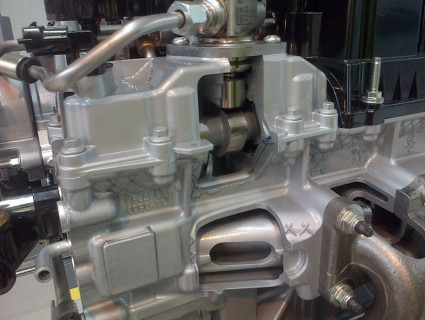Rising demands to dramatically improve fuel economy are putting pressure on automotive engineers to find lighter, better-performing materials for hotter, smaller engines and lighter power trains.
 “High oil prices, increasing environmental awareness and changing political conditions are more and more focusing attention on the energy efficiency of automobiles,” says Martin Baumert, team leader for automotive product development for BASF’s engineering plastics group.
“High oil prices, increasing environmental awareness and changing political conditions are more and more focusing attention on the energy efficiency of automobiles,” says Martin Baumert, team leader for automotive product development for BASF’s engineering plastics group.
The U.S. will require a passenger car fleet average of 36.7 mpg in the 2015 model year, a hike of about 40 percent from the 2010 model year.
OEMs are responding with turbocharged engines in which the pressure of air entering the engine is boosted to create more power. European manufacturers such as Volvo, Saab and Volkswagen have made widespread use of turbocharged engines in recent years.
Now American OEMs are catching up fast. For example, the 3.5-l„“ Ford EcoBoost V6 debuted in four models, including the 2010 Flex. A 2.0-l„“ EcoBoost four-cylinder engine in the 2011 Explorer gets 30 percent better gas mileage than the 4-l„“ V6 it replaces.
Engineers are trying to surround the new engines with plastics that can reduce weight, take the heat and meet chemical-resistance requirements.
“The big goal for design engineers is metal replacement,” says Bill Gaines, automotive industry manager for Solvay Advanced Polymers.
A weight reduction as high as 50 percent can be achieved with plastic-for metal substitution, according to industry estimates. A weight reduction of 220 lb (100 kg) cuts automotive fuel consumption by roughly one-tenth of a gallon per 62 miles traveled.
One example of load-lightening is a direct replacement of die-cast aluminum in mechanical water pump housings with Amodel polyphthalamide (PPA), a semi-aromatic polyamide (nylon).
“Historically, mechanical water pumps had to be made of die-cast aluminum because of their size,”
 says Brian Baleno, a global automotive marketing manager for Solvay Advanced Polymers. “But now as engines are being downsized, other components can also be downsized, reducing their loads. And now the loads allow for the use of thermoplastics.”
says Brian Baleno, a global automotive marketing manager for Solvay Advanced Polymers. “But now as engines are being downsized, other components can also be downsized, reducing their loads. And now the loads allow for the use of thermoplastics.”
It’s a good fit for PPA because its semi-aromatic structure provides resistance to moisture absorption. Hybrid cars are using electric water pumps, whose load can easily accommodate use of plastics.
Gaines estimates that Amodel is growing organically at about 10 percent a year as a result of new engine designs. Part of the growth is coming from Asia.
Cooling applications that typically use water and ethylene glycol are the sweet spot for PPA applications.
Hot Polyamides
Traditional, but improved, polyamides are gaining ground in applications that require heat resistance but don’t require as much chemical or moisture resistance. Target applications are intercooler caps, resonators, charge-air lines, throttle valves and intake manifolds with integrated water-cooled intercoolers.
General Motors chose a revamped polyamide technology for an engine cover in a new-generation turbocharged engine in the 2010 Cadillac CTS. GM had used PPA in the application.
“The operating temperatures for this application are higher than what standard nylons can stand” says Sean Owens, technical leader for GM Powertrain. “We have been looking for lower-cost alternatives.”
GM thermal specifications for the engine cover are 180C for continuous use and 200C peak. He chose a new nylon grade developed by DuPont that works at 210C continuous temperature and 230C peak.
 The new nylons are said to reduce system costs in the range of 10 to 30 percent, according to the nylon suppliers. One advantage over PPA is that cycle times are shorter. PPA requires oil cooling of injection molds and is also available in grades that can be molded in water-cooled tooling.
The new nylons are said to reduce system costs in the range of 10 to 30 percent, according to the nylon suppliers. One advantage over PPA is that cycle times are shorter. PPA requires oil cooling of injection molds and is also available in grades that can be molded in water-cooled tooling.
GM materials’ engineers also require polymer candidates for the new application to have excellent surface finish with potential for flame-retarded grades. To meet part economics requirements, the plastic must also mold in cycles under 60 seconds.
“There is a key cluster of potential applications in the air induction system,” says Klaus Bender, global powertrain lead for DuPont Automotive. “The EGR (exhaust gas recirculation) system is on the radar screen.” The second commercial application for Zytel Plus is an EGR system component for a turbocharged diesel engine (inline four-cylinder).
The 50 percent glass-reinforced plastic must withstand continuous temperatures of 190C and peak temperatures in the range of 210 to 230C. Zytel Plus is replacing die-cast aluminum. One OEM is actively investigating the potential to use the new high-heat nylon in a key structure of the EGR.
A new higher-heat, glass-reinforced polyamide was introduced at K 2010 by BASF.
“The new Ultramid Endure easily withstands continuous use at temperatures up to 220 as well as spikes up to 240C,” says BASF’s Baumert. “This extends the field of application of polyamides into the high-temperature realm.”
For comparison, the previous BASF polyamide – Ultramid A3WG7 – with the same glass-fiber content has a long-term service temperature of 170C, while heat-resistant PA 66/6 grades (Ultramid W2 or Ultramid A3W2G6) can withstand 190C in continuous use.
This improvement in resistance to heat aging is achieved through stabilization technology developed by BASF. Formation of a protective surface layer even at temperatures up to 220C provides continuous protection against attack by oxygen.
BASF estimates that up to 3.3 lb (1.5 kg) of Ultramid Endure can be implemented into a car near the turbocharged engine.
There are examples of other materials’ technologies gaining traction in demanding automotive environments.
Metaldyne is using Victrex polyetheretherketone (PEEK) polymer to replace metal in an innovative gear design that reduces weight and boosts reliability.
“Compared to traditional iron and steel gears, the Victrex PEEK polymer gear gives us about 70 percent less inertia and weight,” says Aaron Clark, engineering manager for Metaldyne Powertrain Products. “That’s important because lower weight and inertia gives us about a three to nine percent reduction in power consumption which results in improved fuel economy in the vehicle.”
Balance shaft modules in the gear design are used to cancel the inherent shaking forces associated with inline four-cyclinder engines.
“Because the modules spin at twice engine speed – up to 15,000 rpm – polymers are not normally used,” says Clark. “The maximum operating temperatures in four-cylinder engines are approaching 155C (311F) and most polymers can’t survive in these conditions.”
PEEK survives at 155C (311F) and also maintains its material properties including fatigue strength, chemical resistance, high temperature resistance and strength, according to Victrex.
“Because they are injection molded, the Victrex PEEK polymer gears require no post machining and this eliminates the need for grinding equipment,” says Smith.
Ford’s Polimotor
In another interesting development, Torlon polyamide-imide, first developed by Union Carbide, is making a comeback in cars.
Swiss-based Quadrant Engineering Plastics Products describes Torlon as the highest-performing melt-processable plastic. It can perform at severe stress conditions at temperatures up to 500F, according to Quadrant, which is a plastics processor.
A 2.3-â„“ engine developed by Polimotor Research with Ford in the 1980s used Torlon for the engine block and other important components. Use of carbon-reinforced Torlon for the valve stems in place of steel reduced weight more than 75 percent, according to Amoco Chemicals, which owned Torlon at that time. Torlon valve spring retainers weighed only 9 gm each versus about 22 gm for steel.
The engine weighed 153 lb versus 415 lb for its iron counterpart. It was an amazing technical advance, but it never made it to production vehicles because it was too big a risk for mainstream car manufacturers, which had substantial investment in the metal casting and other processes still used to make engine components.
 A few companies are using the composite casting process developed by engineer Matty Holtzberg for the Polimotor project. They aren’t using Torlon, however. Their composites are based on phenolic, a thermoset resin with good thermal and chemical resistance properties.
A few companies are using the composite casting process developed by engineer Matty Holtzberg for the Polimotor project. They aren’t using Torlon, however. Their composites are based on phenolic, a thermoset resin with good thermal and chemical resistance properties.
Today, Torlon is again in the conversation under the hood.
“Torlon has been making a comeback in the last four-to-five years,” says Bill Gaines of Solvay Advanced Polymers, which bought Torlon and other engineering plastics from Amoco Chemical.
“One of the growth areas for Torlon is in the compressor side of the turbocharger,” says Baleno. Sealing applications are the first target. Compressor wheels may also be made of Torlon at some point and Torlon is also replacing metal in transmission thrust washers.
Replacement of metals in cars with lighter-weight plastics is a step-by-step engineering process, not the overnight homerun of a Polimotor type of engine. But as CAFE standards skyrocket, engineers will be looking for a bigger role for plastics.
Source : www.designnews.com






